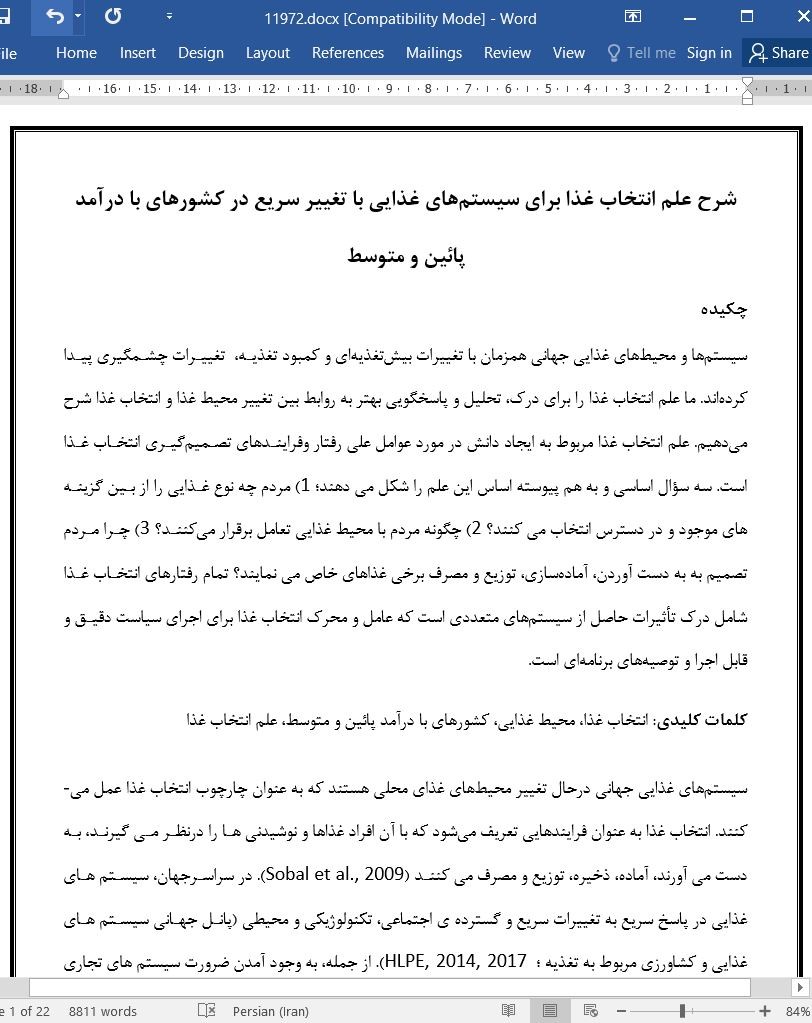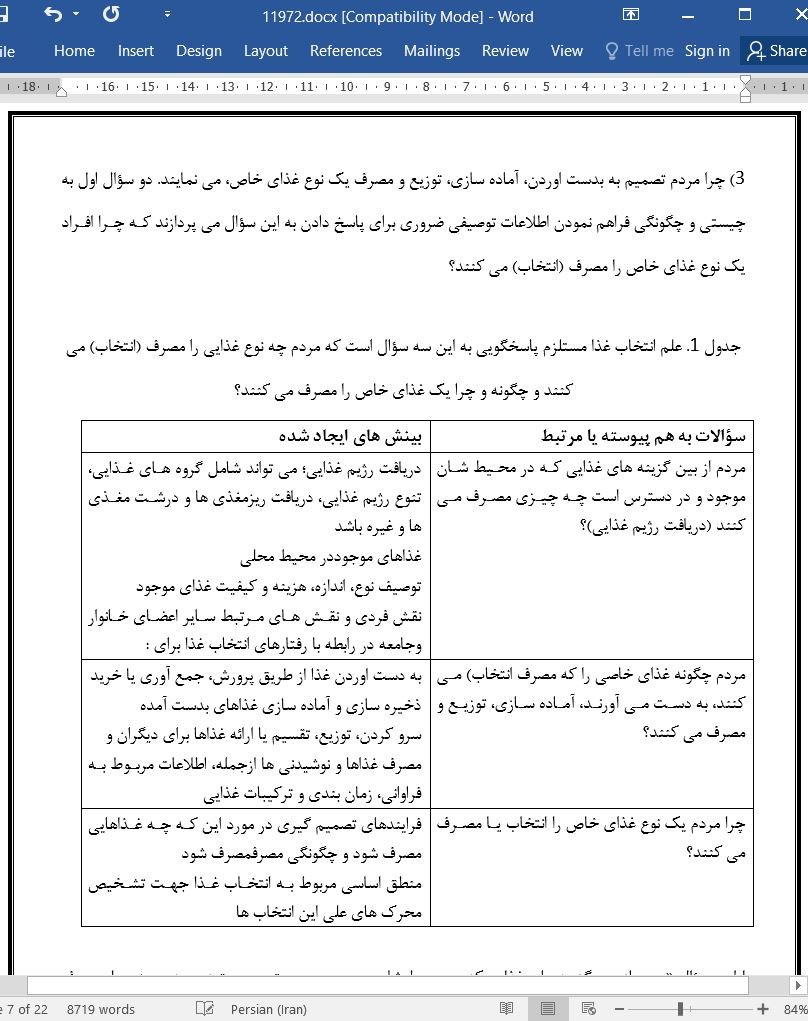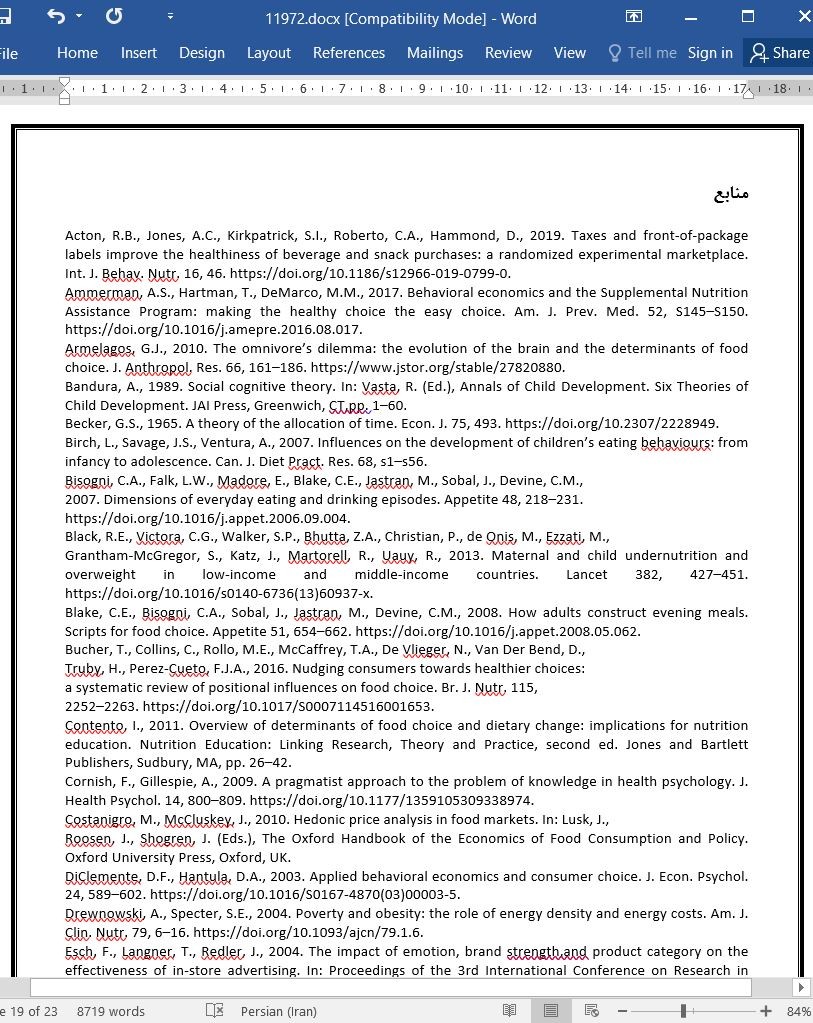
شرح علم انتخاب غذا برای سیستم های غذایی با تغییر سریع در کشورهای با درآمد پائین و متوسط
چکیده
سیستم ها و محیط های غذایی جهانی همزمان با تغییرات بیش تغذیه ای و کمبود تغذیه، تغییرات چشمگیری پیدا کرده اند. ما علم انتخاب غذا را برای درک، تحلیل و پاسخگویی بهتر به روابط بین تغییر محیط غذا و انتخاب غذا شرح می دهیم. علم انتخاب غذا مربوط به ایجاد دانش در مورد عوامل علی رفتار وفرایندهای تصمیم گیری انتخاب غذا است. سه سؤال اساسی و به هم پیوسته اساس این علم را شکل می دهند؛ 1) مردم چه نوع غذایی را از بین گزینه های موجود و در دسترس انتخاب می کنند؟ 2) چگونه مردم با محیط غذایی تعامل برقرار می کنند؟ 3) چرا مردم تصمیم به به دست آوردن، آماده سازی، توزیع و مصرف برخی غذاهای خاص می نمایند؟ تمام رفتارهای انتخاب غذا شامل درک تأثیرات حاصل از سیستم های متعددی است که عامل و محرک انتخاب غذا برای اجرای سیاست دقیق و قابل اجرا و توصیه های برنامه ای است.
سیستم های غذایی جهانی درحال تغییر محیط های غذای محلی هستند که به عنوان چارچوب انتخاب غذا عمل می-کنند. انتخاب غذا به عنوان فرایندهایی تعریف می شود که با آن افراد غذاها و نوشیدنی ها را درنظر می گیرند، به دست می آورند، آماده، ذخیره، توزیع و مصرف می کنند (Sobal et al., 2009). در سراسرجهان، سیستم های غذایی در پاسخ سریع به تغییرات سریع و گسترده ی اجتماعی، تکنولوژیکی و محیطی (پانل جهانی سیستم های غذایی و کشاورزی مربوط به تغذیه ؛ HLPE, 2014, 2017). از جمله، به وجود آمدن ضرورت سیستم های تجاری جهانی پیچیده، تثبیت بازارهای جدید، در محیط ها و چارچوب های قبلا دست نیافته و مشارکت عاملان بخش های خصوصی چند ملیتی تغیر می کنند. این تغییرات، نوع، کیفیت، قیمت، بهداشتی بودن غذاهای موجود برای مصرف کنندگان و غذاهای انتخاب شده توسط آن ها را تغییر می دهند (Holdsworth و Landais، 2019؛ Pinstrup-Andersen و Watson، 2011). تغییرات سیستم غذایی در بین کشورها به یک شیوه ی خطی یکنواخت رخ نمی دهد و هم کشورهای توسعه یافته و هم درحال توسعه، این تغیرات را تجربه کرده اند و به روش های مختلفی به آن پاسخ داده اند ( Lusk و McCluskey، 2018؛ Ruben و همکاران، 2019). تغییرات سیستم غذایی پیچیده و بی سابقه، چالش های بی نظیری را برای ارتقاء رژیم های غذایی سالم و پایدار با کشورهای با درآمد پائین و متوسط (LMIC) نشان می دهد که مستلزم سیاستهای خاص چارچوب و قابل تطبیق و سایر اقدامات و فعالیت ها است (Swinburn و همکاران، 2013؛ Turner و همکاران، 2018؛ Willett و همکاران، 2019). شواهد کمی در مورد بهترین شیوه برای ارتقاء انتخاب غذا در کشورهای LMIC وجود دارد که تغییرات سیستم های غذایی را تجربه کرده اند. درک ارتباطات علی بین سیستم های غذایی و محیط های غذایی و انتخاب غذا جهت توسعه ی اقداماتی که انتخاب غذا را برای رژیم های غذایی سالم و پایدار ارتقاء می بخشد، لازم است. در این گزارش، ما شرحی در مورد علم انتخاب غذا برای ایجاد یک زبان و سازه های معمولی برای تحقیقات مربوط به ارتباط علی بین سیستم های غذایی، محیط های غذایی و انتخاب غذا در کشورهای LMIC ارائه می دهیم.
Abstract
The world's food systems and environments have been changing dramatically, concomitant with changes in over- and undernutrition. We elaborate the science of food choice to better understand, analyze, and respond to relationships between changing food environments and food choice. The science of food choice is concerned with generating knowledge about causal drivers of food choice decision making processes and behavior within immediate food and social environments. Three fundamental and interconnected questions undergird this science; 1) what do people eat from the options available and accessible?; 2) how do people interact with food environments?; and 3) why do people decide to acquire, prepare, distribute, and consume foods as they do? Not all food choice behavior is rational, reflexive, or discrete, but is embedded in wider activities of daily lives. The science of food choice involves understanding influences from multiple systems that drive food choice for deriving sound, actionable policy, and programmatic recommendations.
Global food systems are altering local food environments that serve as the contexts of food choice. Food choice is defined as the processes by which people consider, acquire, prepare, store, distribute, and consume foods and beverages (Sobal et al., 2009). Globally, food systems are changing in response to broad and rapid social, technological, and environmental shifts (Global Panel on Agriculture and Food Systems for Nutrition, 2016; HLPE, 2014, 2017) including emergence of complex global trade systems, establishment of new markets in previously unreached settings and contexts, and involvement of multinational private sector actors. These changes alter the type, quantity, price, and healthfulness of foods available to and chosen by consumers (HLPE, 2017; Holdsworth and Landais, 2019; Pinstrup-Andersen and Watson, 2011). Food system changes do not occur in a uniform linear fashion across countries, and both developed and developing countries have experienced and responded to these changes in different ways (Lusk and McCluskey, 2018; Ruben et al., 2019). Complex and unprecedented food system changes present unique challenges for the promotion of sustainable healthy diets in low- and middle-income countries (LMIC) that will require context-specific and adaptable policies and other actions (Swinburn et al., 2013; Turner et al., 2018; Willett et al., 2019). There is little evidence on how best to improve food choice in LMIC experiencing food systems changes. An understanding of causal linkages between food systems, food environments, and food choice is essential to develop actions that improve food choice for sustainable healthy diets. In this commentary we elaborate the science of food choice to provide a common language and constructs for research on the causal linkages between food systems, food environments, and food choice in LMIC.
چکیده
1. علم انتخاب غذا
2. پنج مشخصه علم انتخاب غذا
3. طراحی مطالعاتی برای پرداختن به سؤالات چیستی، چگونگی و چرایی
بیان تضاد منافع
سپاسگذاری
منابع
Abstract
1. The science of food choice
2. Five characteristics of the science of food choice
3. Designing studies to address what, how, and why?
Declaration of competing interest
Acknowledgments
References
- اصل مقاله انگلیسی با فرمت ورد (word) با قابلیت ویرایش
- ترجمه فارسی مقاله با فرمت ورد (word) با قابلیت ویرایش، بدون آرم سایت ای ترجمه
- ترجمه فارسی مقاله با فرمت pdf، بدون آرم سایت ای ترجمه



